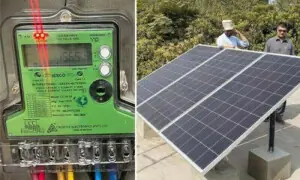Ministry proposes linking subsidies for export sectors with increase in quantities
The Ministry of Finance (MoF) has proposed that subsidies for the export-oriented sectors should be linked to increase in growth in export of quantities instead of banking on increase in prices as multiple incentives are putting substantial burden on the government, well informed sources told Business Recorder.
The Ministry shared its observations at a high-level meeting during discussion on a proposal of Commerce Ministry on “Drawback of Local Taxes Scheme (DLTS) for 2022-23”.
According to Commerce Ministry, to keep up the momentum of export growth trajectory, the ECC approved extension of Prime Minister’s export package for three fiscal years 2018-21. Accordingly, schemes were implemented through Local Taxes and Levies Drawback (LTLD) (non-textile) order SRO. 711((l) 2018 on June 18, 2018 and Duty Drawback of Taxes Order, 2018 (DDT) Textile on August 3, 2018.
Federal government had made an effort to reduce the cost of doing business and increase competitiveness by rationalization of tariffs on raw materials and inputs, regionally competitive energy rates for five export-oriented sectors and market determined exchange rate.
The Ministry claimed that by virtue of this multi-pronged approach, country’s export sectors under both schemes posted a positive growth in exports. Based on fiscal year 2020-21 data, exports under both schemes showed Compound Annual Growth Rate (CAGR) of 6% during the three FYs, i.e., $ 16.18 billion, $ 13.04 billion and $ 13.75 billion in FYs 2020-21, FY 2019-20 and FY 2018-19, respectively. Pakistan posted record overall exports of $ 25.3 billion. This increasing trend in the exports has been demonstrated in majority of the sectors covered under the incentive schemes.
The MoC argued that in order to continue this export growth pattern on sustainable basis, there was a need to further extend drawback incentive scheme for the period of five years with certain modifications/ improvements for export sectors to address their liquidity issues and ensure predictability. The scheme would incentivize product diversification within traditional sectors, new product development to expand export basket, geographical diversification to access markets henceforth not fully exploited and encourage value addition.
Ministry of Commerce further informed the meeting that a new Drawback of Local Taxes Scheme (DLTS) for period of five FYs, i.e., from July 1, 2021 to June 30, 2026 was prepared in consultation with the Finance Division. To this effect, a summary was sent to Finance Division for views/ comments. Subsequently, Finance Division, in its letter of March 4, 2022 furnished their detailed views/ comments on the summary for incorporating its comments in the proposals, such as:
(i) sector-wise fixation of sectoral export targets and pre-allocation of budget to be ensured on medium-term basis; (ii) continuity of DLTL scheme to be made contingent upon achievements of targets; (iii) comment of SBP and FBR to be solicited; (iv) sectors already enjoying subsidized gas and electricity not to be eligible for DLTL supports and proposed budgetary estimated amount of Rs. 141 billion for FY 2021-22 to be rationalized; (v) review mechanism to be made regarding ongoing export industry promotion initiatives and incentives; and (vi) the Prime Minister’s announcement for promotion of IT sector exports to be incorporated in estimates.
MoC contended that Finance Division’s observations have been addressed in the summary. Sector-wise export projections with estimated financial impact from FY 2021-22 to 2025-26 have already been incorporated. Periodic review of the scheme to be introduced to gauge its impact on export performance and early estimated amount of Rs.141 billion for FY 202l-22 has been rationalized to Rs.78.8 billion and major rationalization has been done in zero-rated sectors. Study to determine impact of multiple schemes extended to the export industry has been initiated. Moreover, with respect to promotion of IT sector exports, Ministry of Information Technology and Telecommunication is already in the process of executing a separate financial incentives scheme for IT and IT’s export remittances after its approval by the Cabinet on October 27, 2021.
Ministry of Commerce proposed revised/ rationalized Drawback of Local Taxes Scheme for period of five FYs, i.e., from July 1, 2021 to June 30, 2026 with following salient features:
(i) developmental (new) sectors may be allowed DLT @ 3%, 4% &5%; for diversification in existing sectors, DLT @ 4% may be allowed for continuation of scheme for sectors covered under erstwhile SRO 711(1)/2018 and Notification No 1(42-B) TID-TR-II, DLT @ 1,5 %, 2%, & 3% may be allowed; and additional DLT @ 2% for market diversification covering the markets under both SROs and additional new potential markets; (ii) exports in above categories made through e-Commerce may also be allowed to avail the respective drawback rate under the facility; and (iii) full estimated financial impact will be Rs.79.27 billion for FY 2021-22; however, actual claims till June 30, 2022 are estimated to be around Rs. 50 billion.
The meeting discussed Commerce Ministry’s proposal in detail wherein it was desired that cost benefit analysis of the scheme should be conducted on quarterly basis, preferably through a third party and subsequent decision may be taken up accordingly. It was stated that there must be some accountability mechanism in the scheme, as well. Governor SBP, Dr. Reza Baqir stated that an objective study must be conducted to evaluate the benefit of the subsidy on the growth of exports. He added that the subsidy given to the traditional sectors and especially large-scale manufacturers has resulted in very high profit margins for them. Therefore, the scheme must be reviewed to support appropriate mid-size industries. He added that the Finance Division must present an overall picture of TSGs/ SGs approved for different Ministries/ Division to understand burden on the finances.
Finance Division added that multiple subsidies offered in various shapes like lower cost of energy, etc., are putting substantial burden on the Government, adding that generally increase in exports is not due to increase in quantities rather higher prices of product in the international market. Therefore, it was suggested to link subsidies to the increase in the quantities of export.
After threadbare discussion the meeting took the following decisions: (i) Ministry of Commerce directed to submit a detailed mechanism for undertaking independent impact analysis on “quarterly basis” to review the export performance of the sectors, as well as, exporting firms availing the scheme; (ii) Ministry of Commerce will be provided the funds/ budget amounting to Rs. 50 billion for the FY 2021-22 for the clearance of claims in the scheme; and (iii) while requesting for budget allocation for the scheme for the Fiscal Year 2022-23 and onward, the Ministry of Commerce will submit the detailed impact analysis of the scheme before allocation of the funds.
The story was originally published in Business Recorder on April 04, 2022.
For the latest news, follow us on Twitter @Aaj_Urdu. We are also on Facebook, Instagram and YouTube.





















Comments are closed on this story.